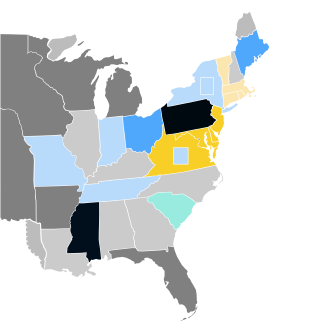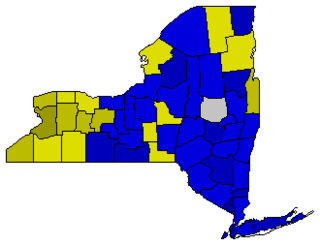A special election was held in Kentucky's 12th congressional district on November 20, 1826, to fill a vacancy caused by the death of Robert P. Henry (J) on August 25, 1826 [1]
| Elections in Kentucky |
|---|
 |
A special election was held in Kentucky's 12th congressional district on November 20, 1826, to fill a vacancy caused by the death of Robert P. Henry (J) on August 25, 1826 [1]
| Candidate | Party | Votes [2] | Percent |
|---|---|---|---|
| John F. Henry | Anti-Jacksonian | 2,208 | 50.7% |
| Chittenden Lyon | Jacksonian | 2,149 | 49.3% |
Henry took office on December 11, 1826. [1] With his victory, the 12th district changed from Jacksonian control to Anti-Jacksonian control, increasing the Anti-Jacksonian membership by one.
The Anti-Masonic Party was the earliest third party in the United States. Formally a single-issue party, it strongly opposed Freemasonry in the United States. It was active from the late 1820s, especially in the Northeast, and later attempted to become a major party by expanding its platform to take positions on other issues. It declined quickly after 1832 as most members joined the new Whig Party; it disappeared after 1838.

The 1832 United States presidential election was the 12th quadrennial presidential election, held from Friday, November 2 to Wednesday, December 5, 1832. Incumbent president Andrew Jackson, candidate of the Democratic Party, defeated Henry Clay, candidate of the National Republican Party.

The 19th United States Congress was a meeting of the legislative branch of the United States federal government, consisting of the United States Senate and the United States House of Representatives. It met in Washington, D.C. from March 4, 1825, to March 4, 1827, during the first two years of John Quincy Adams's presidency. The apportionment of seats in the House of Representatives was based on the 1820 United States census. The Senate had a majority of Jackson Men, while the House had an Anti-Jackson (pro-Adams) majority.

The 20th United States Congress was a meeting of the legislative branch of the United States federal government, consisting of the United States Senate and the United States House of Representatives. It met in Washington, D.C. from March 4, 1827, to March 4, 1829, during the third and fourth years of John Quincy Adams's presidency. The apportionment of seats in the House of Representatives was based on the 1820 United States census. Both chambers had a Jacksonian majority.

The 1828–29 United States House of Representatives elections were held on various dates in various states between July 9, 1828 and October 5, 1829. Each state set its own date for its elections to the House of Representatives before the first session of the 21st United States Congress convened on December 7, 1829. Elections were held for all 213 seats, representing 24 states.

The 1826–27 United States House of Representatives elections were held on various dates in various states between July 3, 1826, and August 30, 1827. Each state set its own date for its elections to the House of Representatives before the first session of the 20th United States Congress convened on December 3, 1827. They occurred during John Quincy Adams's presidency. Elections were held for all 213 seats, representing 24 states.

The 1831 United States Senate election in New York was held on February 1, 1831, by the New York State Legislature to elect a U.S. Senator to represent the State of New York in the United States Senate.

The 1836–37 United States Senate elections were held on various dates in various states. As these U.S. Senate elections were prior to the ratification of the Seventeenth Amendment in 1913, senators were chosen by state legislatures. Senators were elected over a wide range of time throughout 1836 and 1837, and a seat may have been filled months late or remained vacant due to legislative deadlock. In these elections, terms were up for the senators in Class 3.

The 1834–35 United States Senate elections were held on various dates in various states. As these U.S. Senate elections were prior to the ratification of the Seventeenth Amendment in 1913, senators were chosen by state legislatures. Senators were elected over a wide range of time throughout 1834 and 1835, and a seat may have been filled months late or remained vacant due to legislative deadlock. In these elections, terms were up for the senators in Class 2.

The 1832–33 United States Senate elections were held on various dates in various states. As these U.S. Senate elections were prior to the ratification of the Seventeenth Amendment in 1913, senators were chosen by state legislatures. Senators were elected over a wide range of time throughout 1832 and 1833, and a seat may have been filled months late or remained vacant due to legislative deadlock. In these elections, terms were up for the senators in Class 1.

The 1830–31 United States Senate elections were held on various dates in various states. As these U.S. Senate elections were prior to the ratification of the Seventeenth Amendment in 1913, senators were chosen by state legislatures. Senators were elected over a wide range of time throughout 1830 and 1831, and a seat may have been filled months late or remained vacant due to legislative deadlock. In these elections, terms were up for the senators in Class 3.

The 1826–27 United States Senate elections were held on various dates in various states. As these U.S. Senate elections were prior to the ratification of the Seventeenth Amendment in 1913, senators were chosen by state legislatures. Senators were elected over a wide range of time throughout 1826 and 1827, and a seat may have been filled months late or remained vacant due to legislative deadlock. In these elections, terms were up for the senators in Class 1.

The 1824 United States House of Representatives elections in New York were held from November 1 to 3, 1824, to elect 34 U.S. Representatives to represent the State of New York in the United States House of Representatives of the 19th United States Congress.
Elections to the United States House of Representatives were held in Pennsylvania on October 14, 1828, for the 21st Congress. Members of three different parties were elected to the 21st Congress, the first time in US history that a third party won seats. The new Anti-Masonic Party won a total of 5 seats, 1 of which was in Pennsylvania.

The 1824–25 United States Senate Elections were held on various dates in various states. As these U.S. Senate elections were prior to the ratification of the Seventeenth Amendment in 1913, senators were chosen by state legislatures. Senators were elected over a wide range of time throughout 1824 and 1825, and a seat may have been filled months late or remained vacant due to legislative deadlock. In these elections, terms were up for the senators in Class 3.

A special election was held in Kentucky's 3rd congressional district on August 1, 1825, to fill a vacancy caused by the resignation of Henry Clay (A) on March 6, 1825 upon being named Secretary of State by President John Quincy Adams.

A special election was held in Kentucky's 5th congressional district on November 6, 1826, to fill a vacancy caused by the death of James Johnson (Jacksonian) on August 14, 1826.

A special election was held in Maine's 5th congressional district was held on September 11, 1826 to fill a vacancy caused by the resignation of Enoch Lincoln (A) in January, having been elected Governor of Maine. As a majority was not achieved on the first ballot, a second election was held November 27.

The 1832 United States presidential election in New York took place between November 2 and December 5, 1832, as part of the 1832 United States presidential election. Voters chose 42 representatives, or electors to the electoral college, who voted for president and vice president.

The 1832 United States presidential election in Ohio took place between November 2 and December 5, 1832, as part of the 1832 United States presidential election. Voters chose 21 representatives, or electors to the Electoral College, who voted for President and Vice President.